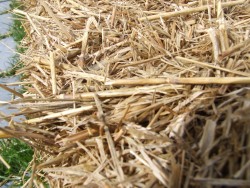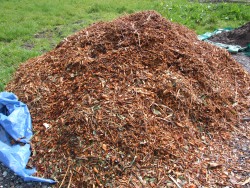Mulch

 What is mulch?
What is mulch?
Mulch is a material that is applied to the soil around plants usually. It has several purposes: it makes the garden bed look more uniform, improves the water retention of the soil, and blocks light to weeds and it is organic when it decays it enriches the soil.
What materials can be used as a mulch?
You can use many types of material as mulch.
Bark chippings are one common form that is easily available to buy.
Other materials are cardboard and newspaper, plastic sheeting, weed suppressant fabric, leaves, straw. Commercially available mulches include strulch which is a mineralised straw material.
So what materials can be used as a mulch?
Bark chippings can be homemade or sourced from commercial suppliers. You may be able to get free chippings from time to time.
Newspaper and cardboard are not pretty to look at and so are best used as a layer under another nicer looking material. They are easily available and can break down quickly whilst stopping the light getting to weeds. They are best applied wet, or soaked in place to ensure they stay where they are.
Straw is great mulch for the vegetable bed. It isn’t as easy to find in cities and towns but you might find a supplier if you’re lucky. Hay is sometimes used but this might carry more weed seeds so is less desirable. If you have stables nearby then ask if you can buy a bale of straw.
Strulch is commercially prepared straw based mulch. It is a pleasing brown colour and is lightweight and easy to apply.
Straw bales are not really light but they’re not too heavy either. If you can get some then you can use the straw as a mulch. Apply after rain, and preferably just before rain so they get wet and are less likely to blow about.
The straw breaks down easily and the worms will help pull it into the soil. After several years of using straw you should find your soil is really beautiful – “soil like multi purpose compost” – is what one straw mulcher told me his soil was like. It’s a wonderful idea that something as simple as covering the soil with straw can help create fantastic soil. He mulches his potatoes and onions with it and digs in the remainder at the end of the year.
Garlic and shallots will grow through a thick mulch of straw but onion sets don’t like be covering up by straw or other mulch, so apply once they get going.
Mulching should reduce weed levels and the amount of weeding you have to do. Plus if the soil has been mulched it should be left baked by the sun which is good news in the current drought warning in the Uk.
If you are worried about depleting the soil of nitrogen when applying a straw mulch then you can feed the soil first.
The functions of mulch
Mulch stops the top surface of soil drying out. This is useful to do when you know there’s a drought on.
Because mulching keeps the moisture from leaving the soil, the plants needs less watering. This is good whether or not you’re in a drought. Less watering means less work!
Mulching protects the soil from the wind.
Mulching improves the soil. As mulch breaks down (worms and bacteria in the soil) it improves the quality of the soil.
Mulching thickly prevents weeds.
Mulching on paths can help stop them being slippy. This is especially true in damp weather.
The mulch acts as a blanket to keep the soil at the right temperature. This can regulate the temperature experienced at the plants roots.
Mulch can act as a frost protector. It’ll stop frosts damaing roots near the surface. It is useful for plants which have roots near the surface which might be damaged by hoeing.
Mulching can act as a feed for the soil providing nitrogen as it breaks down.
Worms are happy under mulch and will love the extra organic material for them to take down into the soil.
Mulching can stop soil from splashing up on plants that grow low to the ground. Think french beans – and how muddy they can get after it rains.
Mulching can be made from different materials. It is possible to mulch with fresh plants.
Long term mulch use increases soil depth and quality.
Mulching means your soil is in better shape.
It will save you time on watering, weeding and worrying!
Mulch can be used to cover up crops like potatoes that might go green if exposed to sunlight.
Pine bark is acid – which makes it useful for putting around blueberries! So shred that christmas tree but don’t put the shreddings on anywhere other than acid loving plants.






